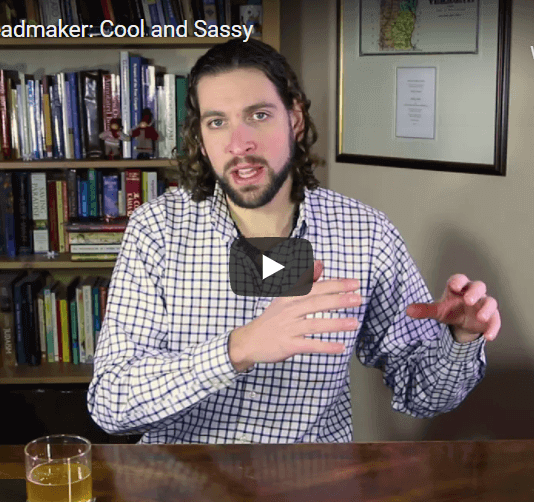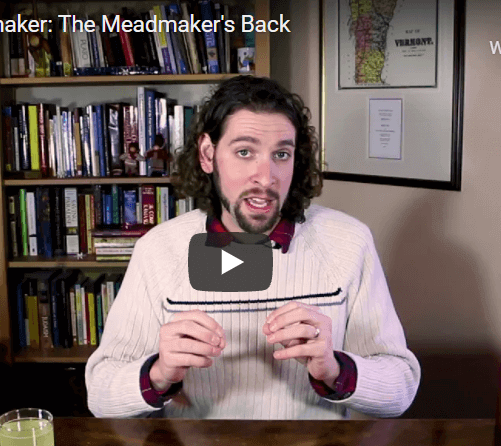In which Ricky the Meadmaker answers questions about making mead in mason jars, oxygenating, brewing with strange ingredients, and more!
An Argument for Homebrewing Big
Your First Batch of Mead
Brewing with Strange Ingredients
Probably the most common question I'm asked when I'm being interviewed is, "Why Vermont, of all the many states that we have, all 36 or whatever we're up to now, why Vermont? Why open a meadery in Vermont?" And the answer varies depending on who asks me because I can usually tell what kind of answer they want. But here's a fact. Last night when I was going to bed, it was -24˚K outside my home, and I managed to get it up to 66˚F inside my home, which is a 90˚F difference between the outside and the inside of my house and I'm carried all that wood into the house, just to push it up to 66. Or to put it another way, just going to bed in Vermont comes with bragging rights.
Welcome to Ask the Meadmaker, where I, Ricky the Meadmaker, answer your questions about mead making, mead drinking, mead brewing, and really any question you're willing to send to me. Our first one this week comes from Tim Bulfur. Sounds like a hobbit. "Would you please share some tips for making extremely small batches? I bottled two different one-quart batches made in my modified mason jars." I wonder how he modded them. "But both of them taste extremely alcoholic. I would call it Everclear-flavored. I've never had this problem with pico-batches of cider. So, what am I doing wrong?" I don't know what you're doing wrong to make your mead taste like Everclear. But I know what you're doing wrong in general. Don't make one-quart batches. You're wasting your time. Buy a bucket. Buy some honey and make a normal, grown-up sized batch of mead. I have written about this so many times. What if it's bad? What if it's good?
Our next question comes from Liz D, who wants to know if she can use flip top bottles instead of normal wine bottles. Liz D, I don't care what you use, as long as you don't use those ones that look like cats. Full disclosure, it turns out this is one of my sassier episodes.
MonkeyTreey says, "Hey there, do you have any tips on label design? What information in your opinion, should a homebrew mead contain? ABV? ingredients? Flavor profile? A bunch of people weighed in, they had lots of good advice and I didn't really have much to add. But this was posted a year ago. Since then, the non-homebrew world, the federal world, the commercial world that I live in, a whole bunch of crazy crap added to our labels. Some packaging has to have only metric on it. Some packaging has to have standard but can also have metric. Let's see. Certain ones now have to have nutrition information. Which makes no sense. So, my advice is to embrace the fact that you're a homebrewer. Put all the things on your label that I'm not allowed to. I feel like you should call it beer. Call it beer. Confuse the heck out of your friends. Put it in irregularly-sized bottles, Mismark them. But then look into some real nitty-gritty, put in things that talk about how this is the conception of a man and a woman and describe it very graphically, because apparently, you're not allowed to put that on packaging anymore, either. You, if you're in Connecticut, I don't know where you're from, you should put things about how Santa Claus made it. Connecticut decided that Santa Claus is a religious figure, which makes it sacrilegious so you can't put it on your beer. I guess my point is, go wild for me.
Sam Curtis has a question that I can't think up a sassy response to but it's a good question, so I'll answer it regardless. He wants to know, in the videos he sees on YouTube where people oxygenate once or twice a day for the first several days of fermentation, is this necessary? Is it good? Is it bad? Really, I like this about Sam, he wants to know if it's necessary because that's kind of how I brew. The answer is, you need to establish whether they're actually oxygenating, putting new air in, or degassing, knocking bubbles out. You can actually degas with CO2, the nucleation points on the outside of a stone will burst and then push the bubbles up and out. So, you can degas with more CO2, which is kind of crazy. So, if they're oxygenating, first couple days, not the end of the world, it just causes more budding in the yeast, which means you might have a larger colony at the end of your batch. But it could also add like weird Sherry and papery off flavors. So, it's something you need to be very careful about.
Our final questions this week come from Tango Cortez, and don't worry, I'm back to being sassy. Tango Corte has two unrelated questions and very unrelated they are. First. "Is Groennfell Meadery in the path of totality for the 2024 solar eclipse?" Comparing maps, it looks close to the edge of the path. So, I can't tell for certain. I would love both to visit Groennfell Meadery and to see a total eclipse. Who wouldn't? Problem is, you knew that there was a map that showed where the totality was going to be. I did not know that until you wrote to me, meaning you're way out ahead of me on this one. Now, I have two friends at NASA, who I could write to. The problem is I know exactly what they do. They would also Google and find the same map that you were using. So, you should write to me and just tell me when you're visiting.
Next question. "Can I make mead out of juice with artificial flavoring? I bought a salted caramel flavored apple juice. Not going to be sassy about that. That tasted rather nice. Oh, lovely. So, it occurred to me to use it for a cyser. I wonder if the flavor would pleasantly lend itself to the cyser, or if it would disappear, or if it would become disgusting, or if its presence would make serious brewers recoil in horror regardless." The end result, Tango Corte, the only thing I can absolutely guarantee is that last one. Problem is, serious brewers. Good brewers are not the same thing. See I am drug across the coals on a regular basis, because I recommend wild things like slightly warmer fermentations, or slightly more nutrient, or any number of horrific concepts like that. What I usually say is try it. Just try it. And if it makes good mead, keep using it. And if it doesn't, stop. You see, I'm very much of the mindset that if you make something that has honey, water and anything else in it and it tastes good, you're a good meadmaker. If you use salted caramel apple nonsense, which is almost certainly discontinued by now, sorry it's been so long, and it tastes good, you're a good meadmaker. That's it. It's no harder than that. Put ingredients together. And wait. If it tastes good, you've succeeded. So, Tango Corte, go with my blessing. Make it with salted caramel apple if it's still available at your local Walgreens or wherever you picked it up and send me a bottle.
That's our last question for this week. I believe I will be less sassy next time I see you. Keep sending your questions. Cheers.




